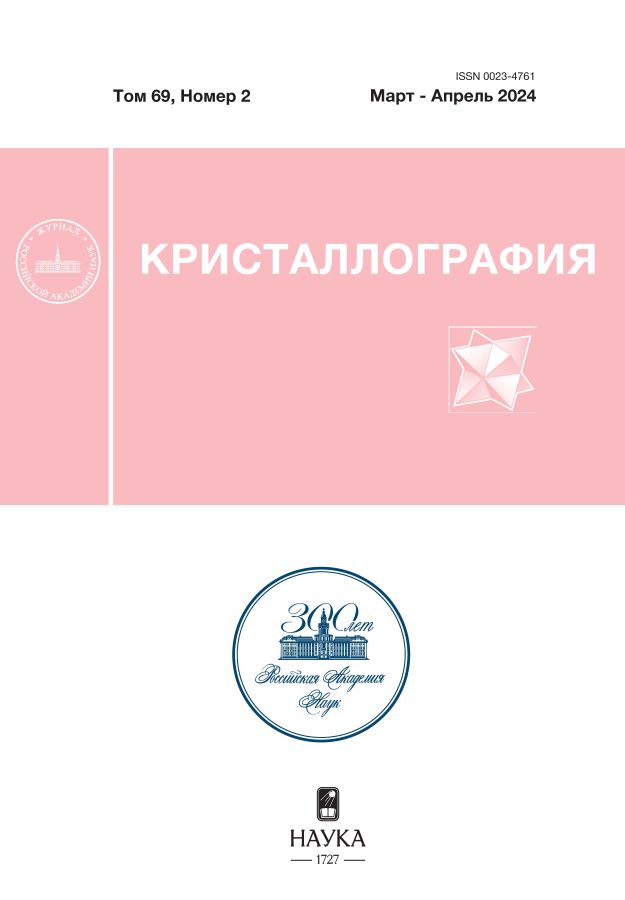Oligomerization of IHF protein in the presence of metal cations
- 作者: Gordienko A.M.1, Dadinova L.A.1, Petoukhov M.V.1,2,3, Mozhaev A.A.1,2, Manuvera V.A.4,5, Lazarev V.N.4,5, Shtykova E.V.1
-
隶属关系:
- Shubnikov Institute of Crystallography of Kurchatov Complex of Crystallography and Photonics of NRC “Kurchatov Institute”
- Shemyakin–Ovchinnikov Institute of Bioorganic Chemistry, Russian Academy of Sciences
- A.N. Frumkin Institute of Physical Chemistry and Electrochemistry, Russian Academy of Sciences
- Lopukhin Federal Research and Clinical Center of Physical-Chemical Medicine of Federal Medical Biological Agency
- Moscow Institute of Physics and Technology
- 期: 卷 69, 编号 2 (2024)
- 页面: 268-276
- 栏目: STRUCTURE OF MACROMOLECULAR COMPOUNDS
- URL: https://ter-arkhiv.ru/0023-4761/article/view/673207
- DOI: https://doi.org/10.31857/S0023476124020105
- EDN: https://elibrary.ru/YSYOUV
- ID: 673207
如何引用文章
详细
The oligomeric state of the nucleoid-associated protein IHF (integration host factor) plays a significant role in organizing and compacting bacterial nucleoids, as well as in the process of bacterial resistance to adverse environmental conditions, including antibiotics. Although IHF was identified more than 25 years ago, the molecular mechanisms of its involvement in such processes remain poorly understood. In this study, using small-angle X-ray scattering, various oligomeric forms of IHF were first identified in aqueous solution depending on the presence of metal cations. It was found that the presence of Mg2+ and K+ ions inhibits the formation of high-order oligomers. The obtained data can be useful in developing strategies to overcome bacterial resistance to drugs.
全文:
作者简介
A. Gordienko
Shubnikov Institute of Crystallography of Kurchatov Complex of Crystallography and Photonics of NRC “Kurchatov Institute”
编辑信件的主要联系方式.
Email: alex.gor99@mail.ru
俄罗斯联邦, Moscow
L. Dadinova
Shubnikov Institute of Crystallography of Kurchatov Complex of Crystallography and Photonics of NRC “Kurchatov Institute”
Email: alex.gor99@mail.ru
俄罗斯联邦, Moscow
M. Petoukhov
Shubnikov Institute of Crystallography of Kurchatov Complex of Crystallography and Photonics of NRC “Kurchatov Institute”; Shemyakin–Ovchinnikov Institute of Bioorganic Chemistry, Russian Academy of Sciences; A.N. Frumkin Institute of Physical Chemistry and Electrochemistry, Russian Academy of Sciences
Email: alex.gor99@mail.ru
俄罗斯联邦, Moscow; Moscow; Moscow
A. Mozhaev
Shubnikov Institute of Crystallography of Kurchatov Complex of Crystallography and Photonics of NRC “Kurchatov Institute”; Shemyakin–Ovchinnikov Institute of Bioorganic Chemistry, Russian Academy of Sciences
Email: alex.gor99@mail.ru
俄罗斯联邦, Moscow; Moscow
V. Manuvera
Lopukhin Federal Research and Clinical Center of Physical-Chemical Medicine of Federal Medical Biological Agency; Moscow Institute of Physics and Technology
Email: alex.gor99@mail.ru
俄罗斯联邦, Moscow; Dolgoprudny
V. Lazarev
Lopukhin Federal Research and Clinical Center of Physical-Chemical Medicine of Federal Medical Biological Agency; Moscow Institute of Physics and Technology
Email: alex.gor99@mail.ru
俄罗斯联邦, Moscow; Dolgoprudny
E. Shtykova
Shubnikov Institute of Crystallography of Kurchatov Complex of Crystallography and Photonics of NRC “Kurchatov Institute”
Email: alex.gor99@mail.ru
俄罗斯联邦, Moscow
参考
- Dame R.T., Rashid F.-Z.M., Grainger D.C. // Nat. Rev. Genet. 2020. V. 21. P. 227. https://doi.org/10.1038/s41576-019-0185-4
- Rohs R., West S., Sosinsky A. et al. // Nature. 2009. V. 461. P. 1248. https://doi.org/10.1038/nature08473
- Shahul Hameed U.F., Liao C., Radhakrishnan A.K. et al. // Nucl. Acids Res. 2019. V. 47. P. 2666. https://doi.org/10.1093/nar/gky1299
- Bai L., Morozov A.V. // Trends Genet. 2010. V. 26. P. 476. https://doi.org/10.1016/j.tig.2010.08.003
- Wang W., Li G.W. Chen C. et al. // Science. 2011. V. 333. P. 1445. https://doi.org/10.1126/science.1204697
- Frenkiel-Krispin D., Ben-Avraham I., Englander J. et al. // Mol. Microbiol. 2004. V. 51. P. 395. https://doi.org/10.1046/j.1365-2958.2003.03855.x
- Rice P.A., Yang S., Mizuuchi K. et al. // Cell. 1996. V. 87. P. 1295. https://doi.org/10.1016/s0092-8674(00)81824-3
- Grant R., Filman D., Finkel S. et al. // Nat. Struct. Mol. Biol. 1998. V. 5. P. 294. https://doi.org/10.1038/nsb0498-294
- Luijsterburg M.S., Noom M.C., Wuite G.J. et al. // J. Struct. Biol. 2006. V. 156. P. 262. https://doi.org/10.1016/j.jsb.2006.05.006
- Frenkiel-Krispin D., Minsky A. // J. Struct. Biol. 2006. V. 156. P. 311. https://doi.org/10.1016/j.jsb.2006.05.014
- Дадинова Л.А., Петухов М.В., Гордиенко А.М. et al. // Биохимия. 2023. Т. 88. № 5. С. 785. https://doi.org/10.31857/S032097252305007X
- Lee S.Y., Lim C.J., Droge P. et al. // Sci. Rep. 2016. V. 5. P. 18146. https://doi.org/10.1038/srep18146
- Nash H.A., Robertson C.A. // J. Biol. Chem. 1981. V. 256. P. 9246. https://doi.org/10.1016/S0021-9258(19)52537-6
- Hales L.M., Gumport R.I., Gardner J.F. // J. Bacteriol. 1994. V. 176. P. 2999. https://doi.org/10.1128/jb.176.10.2999-3006.1994
- Lin J., Chen H., Dröge P. et al. // PLoS One. 2012. V. 7. № 11. https://doi.org/10.1371/journal.pone.0049885
- Holbrook J.A., Tsodikov O.V., Saecker R.M. et al. // J. Mol. Biol. 2001. V. 310. № 2. P. 379. https://doi.org/10.1006/jmbi.2001.4768
- Feigin L.A., Svergun D.I. Structure analysis by small-angle x-ray and neutron scattering. New York: Plenum Press, 1987. 335 p.
- Peters G.S., Zakharchenko O.A., Konarev P.V. et al. // Nucl. Instrum. Methods Phys. Res. A. 2019. V. 945. P. 162616. https://doi.org/10.1016/j.nima.2019.162616
- Peters G.S., Gaponov Y.A., Konarev P.V. et al. // Nucl. Instrum. Methods Phys. Res. A. 2022. V. 1025. P. 166170. https://doi.org/10.1016/j.nima.2021.166170
- Hammersley A.P. // J. Appl. Cryst. 2016. V. 49. P. 646. https://doi.org/10.1107/S1600576716000455
- Konarev P.V., Volkov V.V., Sokolova A.V. et al. // J. Appl. Cryst. 2003. V. 36. P. 1277. https://doi.org/10.1107/S0021889803012779
- Manalastas-Cantos K., Konarev P.V., Hajizadeh N.R. et al. // J. Appl. Cryst. 2021. V. 54. P. 343. https://doi.org/10.1107/S1600576720013412
- Konarev P.V., Svergun D.I. // IUCr J. 2015. V. 2. P. 352. https://doi.org/10.1107/S2052252515005163
- Svergun D.I. // J. Appl. Cryst. 1992. V. 25. P. 495. https://doi.org/ 10.1107/S0021889892001663
- Porod G. Small-Angle X-Ray Scattering ed O Glatter and O Kratky. London: Academic, 1982.
- Petoukhov M.V., Franke D., Shkumatov A.V. et al. // J. Appl. Cryst. 2012. V. 45. № 2. P. 342. https://doi.org/10.1107/S0021889812007662
- Svergun D.I., Barberato C., Koch M.H.J. // J. Appl. Cryst. 1995 V. 28. P. 768. https://doi.org/10.1107/S0021889895007047
- Konarev P.V., Volkov V.V., Sokolova A.V. et al. // J. Appl. Cryst. 2003. V. 36. P. 1277. https://doi.org/10.1107/S0021889803012779
- Свергун Д.И., Фейгин Л.А. Рентгеновское и нейтронное малоугловое рассеяние. М.: Наука, 1986. 278 c.
- Jacques D.A., Guss J.M., Svergun D.I. et al. // Acta Cryst. D. 2012. V. 68. P. 620. https://doi.org/10.1107/S0907444912012073.
- Guinier A. // Ann. Phys. 1939. V. 12. P. 161.
补充文件












